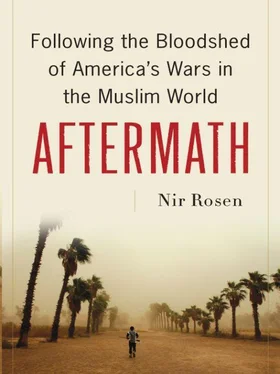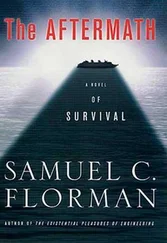As Iraq became a less hospitable place for jihadists and foreign fighters, or as there were less American targets to go after, these veterans, experienced at fighting the most advanced army in the world, were looking for new battles. Andrew Exum is a former U.S. Army officer who led a platoon of light infantry in Afghanistan in 2002 and then led a platoon of Army Rangers in Iraq and Afghanistan in 2003 and 2004. He lived in Beirut from 2004 until 2006, and now researches insurgencies and militant Islamist groups at the Center for New American Security in Washington, D.C. “The fighting in Nahr al-Bared is, unfortunately, just the first round in what I fear will be a series of battles fought in the aftermath of the Iraq War,” he says. “On Internet chat rooms, we’re seeing militants turn away volunteers to go fight in Iraq and promising the next fight will be in Lebanon and the Gulf. Lebanon, especially, is a magnet for Sunni extremists. You not only have a haven for these groups in the Palestinian camps—with security services from rival Arab states competing for their loyalty and attention—you also have two tempting targets: both the pro-Western ruling coalition in Beirut as well as the opposition, led by a powerful bloc of Shiite parties. How can we not expect these Sunni militants, who have spent the past four years waging war on the Shiites of Iraq, to try and carry that fight onto the large, politically active Shiite population in Lebanon? Or onto the pro-Western regime that precariously hangs onto power?”
FOLLOWING THE CIVIL WAR Iraq became a less prominent topic on the jihadi web forums. In part the novelty factor wore off. But Iraq was a loss for the jihadists, and as it grew bloodier, with more civilians being targeted, it was less inspiring for aspiring jihadists than merely fighting against the crusader and occupier. But there was very little soul-searching on the forums; jihadis seemed to have moved on without a lot of serious public discussion of what went wrong. This was partly because fighting picked up in other places after 2005, especially in Afghanistan, Lebanon, and Somalia.
And while America’s militaristic ambitions will likely engender violent resistance movements regardless of the ideological environment, a major reason for the growth of Al Qaeda is now something beyond anti-Americanism. It is the internal war between Sunnis and Shiites in places like Lebanon, Iraq, Pakistan, and even Yemen. Al Qaeda can no longer be seen as just a force against U.S. encroachments; it is now part of these local phenomena. In this internal war in the Muslim world, Al Qaeda has become a major driving force of Sunni-Shiite hatred. Al Qaeda in this case means something more general than the actual organization. Even in moderate Lebanon, sectarian Sunnis have been Salafized. They may not have been religious beforehand, but they view Al Qaeda as an effective way to combat perceived Shiite expansion and a potent symbol for them to reclaim their masculinity. One of the many ramifications of this is that the United States is yet again involving itself in forms of spiraling violence whose outcomes are unpredictable and whose unintended consequences will be keeping it busy for decades to come.
Part Three

THE SURGE
CHAPTER SEVEN
“Iraqi Solutions for Iraqi Problems”
BY LATE 2006 IRAQ SEEMED LOST, A FAILED STATE, HEADING TOWARD Rwanda and threatening to provoke a regional conflict. There was finally a sense among Americans in Baghdad that things were going wrong. The First Cavalry Division of the U.S. Army—known as the “First Team”—took over the headquarters of Multi-National Division Baghdad (MND-B), the major U.S. military unit responsible for the city of Baghdad, in November 2006. Before its arrival, military policy was directed to handing over more authority to the Iraqi Security Forces. As one embedded planner with the Fourth Infantry, who were previously in charge of Multi-National Division Baghdad, told me, “[We were] struggling to control violence when the prime directive was to downsize and turn over responsibility to the Iraqi Security Forces as fast as humanly possible. Al Qaeda and the Mahdi Army filled the void and were trying to ‘cleanse’ the opposing sect from their perceived areas of influence.” But the Iraqi Security Forces were hugely compromised. I was told that every new Iraqi army unit being deployed to Baghdad would first spend two weeks in the Bismaya range in Diyala to train. While training there, the Mahdi Army would contact these units and tell them to leave them alone. “The Iraqi army couldn’t do the right thing if they wanted to, because politicians would pressure them,” one deputy brigade commander told me.
Maj. Gen. Joseph Fil, commander of the First Cavalry Division, who in November 2006 became the commanding general of MND-B, told a subordinate in September 2006, “I don’t know what we are going to do in Baghdad. I do know we are not going to keep doing what they’re doing.” “We were all very vested in Baghdad,” a key author of the change in American strategy from the First Cavalry told me. “First Cav felt very possessive of the place and realized it was burning and that the old ways weren’t working.”
The new priority was to focus on protecting the Iraqi population from violence and slow down the transition to the Iraqi Security Forces. The increase in troops that would become known as the “surge” would be much more than an additional thirty thousand American troops. It heralded a change in doctrine and tactics. The Americans would live in the neighborhoods, not merely in massive Forward Operating Bases (FOBs) cordoned off from the general population, from where they would “commute to work.” They would implement population-centric counterinsurgency, designed to secure, or control, the population and win their allegiance at the expense of rival guerrilla forces.
Before the surge the Americans would take Iraqi National Police (INP) units offline for extra training, including on the rule of law and human rights. It was called a “reblueing exercise,” but it never worked. The Americans would go in and clear an area, leaving the INP there. In operations such as Together Forward I and II, from 2006, the American unit would report that it cleared one thousand houses and twenty mosques, and confiscated twenty AK-47s. Then they would leave the INP, and violence would get worse, as happened in Ghazaliya. It took Zarqawi to push the Iraqi Security Forces to take their work seriously, and they did this with the help of power drills and death squads, punishing Sunnis en masse until the will of the resistance was broken. It wasn’t in the counterinsurgency manual, but it worked.
Baghdad was the sine qua non for everything the Americans were trying to do, but at the National Security Council they realized it was falling apart. Brett McGurk, the NSC’s director for Iraq, was writing daily reports for President Bush about security in Baghdad, arguing that the military strategy was not working. In August 2006 National Security Adviser Stephen Hadley asked McGurk and Meghan O’Sullivan to work on a review of Iraq policy. All the Iraqis McGurk knew from his time in the country in 2004 were fleeing, hiding in the Green Zone, or dead. The son of one Iraqi judge he was friends with was killed right outside the Green Zone.
McGurk looked at past similar civil wars and concluded that it took a neutral force to provide a presence and stabilize the country, but the ISF wasn’t neutral (and neither, of course, were the Americans). McGurk believed that the Americans did not have enough troops to achieve their ends, that their mission was not properly resourced. In the summer of 2006, he made his position clear to the president. Hadley knew that McGurk and O’Sullivan were advocates of a troop surge, but he didn’t want the media to say the NSC supported such a surge, because it would immediately form antibodies before they could even do a review. He told them never to use the word “surge.” Gen. John Abizaid, the commander of U.S. forces in the Middle East, was opposed to an increase in troops, as were Secretary of State Rice, Defense Secretary Rumsfeld, and Gen. George Casey, commander of U.S. forces in Iraq.
Читать дальше












